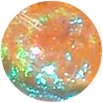

Opal is an amorphous form of silica with a chemical structure of SiO2.nH2O. A typical opal contains 3% to 21% water within its mineral structure with gem quality opals having a water content of 6% to 10%. Opals are sedimentary stones. This means that opals are created from silicates dissolved in water. As the silicate rich water enters a cavity on the bed of a body of water the silicates are deposited as tiny spheres. The arrangement and the size of these tiny spheres will determine how the light is reflected and therefore the colour of the opal. If the deposits are random in shape and arrangement we have a common, non-gem quality opal. Because of thew way it is formed, almost every opal is unique. Opals are richin colour and turning them in the light reveals brilliant flashes of different colours. The Roman historian Pliny described opals as having "the fire of the carbuncle, the brilliant purple of the amethyst and the sea green colour of the emerald, all shining together in incredible union". The quality of an opal is judged by the number of colours it shows and the evenness of the pattern.
In fact, the name actually evolved from the Greek "Opallus" which means 'to see a change in colour'. Later, the Latin word "opalus" came to mean precious stone. Today about 95% of the world's opals are from Australia. Most are found in the Australian outback, around the margins of an ancient inland sea that covered almost one third of Australia around 110 million years ago, in the Cretaceous period. The opal is found in small pockets between layers of sandstone in the clay beds that once formed the floor of this great lost sea. The main exception to Australia's opal monopoly is fire opals which come predominantly from Mexico.
Types of opal

Black opal - has a dark background colour. The dark base colour shows up the gem colours more brilliantly than in any other kind of opal. Therefore black opals are the most valuable of opals. Volcanic ash gives black opal its colour, but the brilliancy of the stone is all to do with the regularly arranged tiny silicate spheres. These must be smaller than 1500 angstroms for blue and violet to show, and no larger than 3500 angstroms for oranges and reds. Black opal is rare and nearly all of the world's supply of black opal is mined at Lightning Ridge in New South Wales, Australia.
 White opal - has a light background, and the colours displayed tend toward pastel hues meaning white or light coloured stones. Light opal is mined mainly at Coober Pedy, Mintabie and Andamooka in South Australia and at White Cliffs in New South Wales; some light opal is found at Lightning Ridge.
White opal - has a light background, and the colours displayed tend toward pastel hues meaning white or light coloured stones. Light opal is mined mainly at Coober Pedy, Mintabie and Andamooka in South Australia and at White Cliffs in New South Wales; some light opal is found at Lightning Ridge.
Crystal opal - has a colourless background but still exhibits a range of colours. Indeed many crystal opals can be truly beautiful. Crystal opal is mined mainly at Andamooka in South Australia and at Lightning Ridge in New South Wales.
Boulder opal -  coloured opal found within a iron-rich sandstone. It is named after the boulder-shaped lumps of ironstone in which it is often found. The dark-coloured stone gives some boulder opal a brilliance similar to that seen in black opal. However, most boulder opals are composed of thin, wavy sheets.
coloured opal found within a iron-rich sandstone. It is named after the boulder-shaped lumps of ironstone in which it is often found. The dark-coloured stone gives some boulder opal a brilliance similar to that seen in black opal. However, most boulder opals are composed of thin, wavy sheets.
Fire opal - is also fairly transparent, but its background colour may be yellow, orange, red or brown. Sometimes it doesn't even have the typical play of colour. It's often called Mexican opal because Mexico is the major source. Fire opal with a red body colour is is often referred to as cherry opal.
Common opal - is a variety which does not contain the brilliancy and colour of the gem variety. Whereas gem opal contains microscopic spheres arranged in a regular array, in common opal the arrangement of spheres is irregular. The best-known common opal is potch, which may be black, grey, white or amber-coloured.
Wood opal - is wood which has been replaced in part by opaline silica.

| _______________________________ | ||||
| Home | | | Shopping | | | Database |
© Biscuit Software 2004-2015
All rights reserved